10 Types Of Biscuits And How They Differ
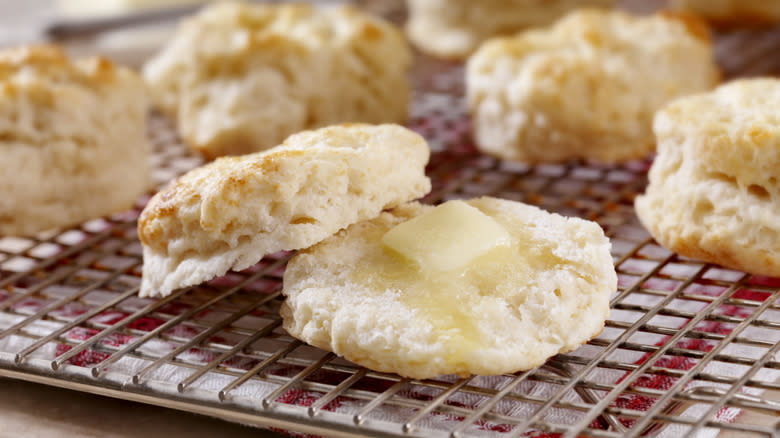
Biscuits are one of the country's favorite foods. They're versatile and can show up at any meal, and they come in so many different flavors and forms that there's bound to be at least one that you love to eat. Biscuits in the U.S. can be bready, cakey, and anything in between, and they have a long history of sustaining populations from those who arrived on ships centuries ago to those grabbing a bite to eat at a fast food restaurant today.
Unlike cookies, which the word "biscuit" refers to outside the U.S., American biscuits are a key part of a meal in some regions. They're some of the easiest foods to make, and short of completely burning them, it's difficult to turn out a truly bad biscuit as long as you follow the recipe. If you want to give homemade biscuits a try, first you need to know what types of biscuits are out there.
Read more: 15 Mistakes Everyone Makes When Cooking Eggs
Buttermilk
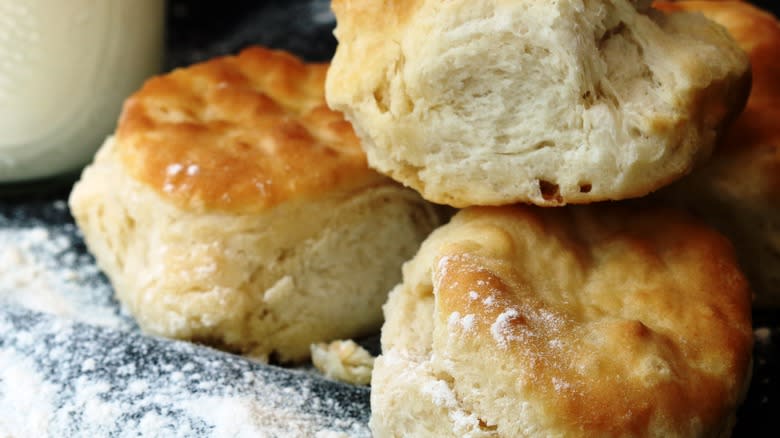
Possibly the most common and classic American biscuit today -- the biscuit that you expect to get with your meal in a restaurant or to have with a full breakfast, for example -- is the buttermilk biscuit. It doesn't look very different from any other biscuit that's been cut out of rolled-out and laminated dough, but adding that buttermilk changes the taste from floury to just a bit tangy. These biscuits are soft and, when cut correctly, they produce those lovely, flaky layers. They're great to have with any meal and are divine when hot and slathered with butter. The buttermilk biscuit even has its own day of celebration; National Buttermilk Biscuit Day is on May 14.
Could you add a different sour dairy product to biscuit dough if you didn't have buttermilk available? Sure, of course you could, but the flavor and texture could be very different, depending on the product. Typically in this type of biscuit, you want to use a liquid that's not too fatty. Buttermilk obviously has the thinner consistency of milk but produces a more tender baked biscuit than plain milk would. Using milk with a spoonful of lemon juice or vinegar should work just as well, by the way. Other dairy products would be too creamy and change the texture of the baked biscuit.
Beaten
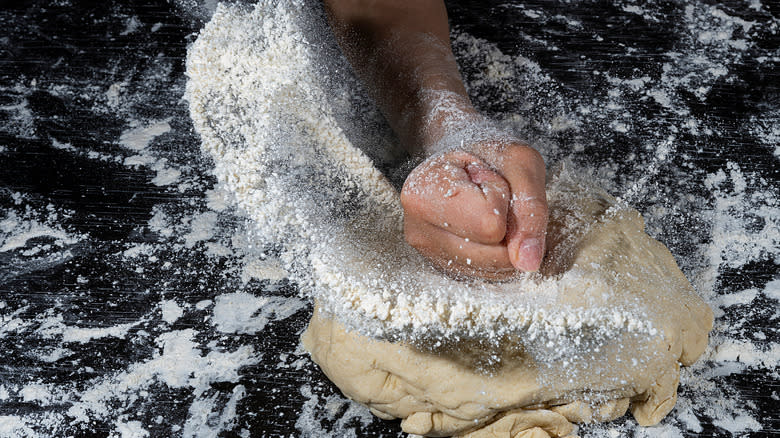
When biscuits first made their way to North America, they were very different from what you'd call a biscuit now. Those biscuits were actually hardtack, those extremely hard crackerlike discs that were baked to oblivion so they'd last on long ship journeys. Yeast was expensive, and baking soda and baking powder were not even known back in the 16th, 17th, and 18th centuries. But cooks realized that beating the dough -- literally, with something like a rolling pin for at least an hour -- could make the biscuits rise up a bit more by forcing air into the dough.
By the 19th century, baking soda and baking powder finally showed up in the culinary scene, allowing cooks to create biscuits that rose higher and that were softer than hardtack, sometimes known as sledgling biscuits. But beaten biscuits didn't go away; in fact, they flourished when the biscuit brake was invented. This was a machine that let cooks feed dough into a series of rollers that would beat the dough as it passed through. Nowadays, beaten biscuits are not as jaw-achingly hard as traditional hardtack, although they can be dry and not very tasty by themselves. They are, however, great if you want a baked-dough product as a background flavor or texture for other foods like ham.
Sour Cream
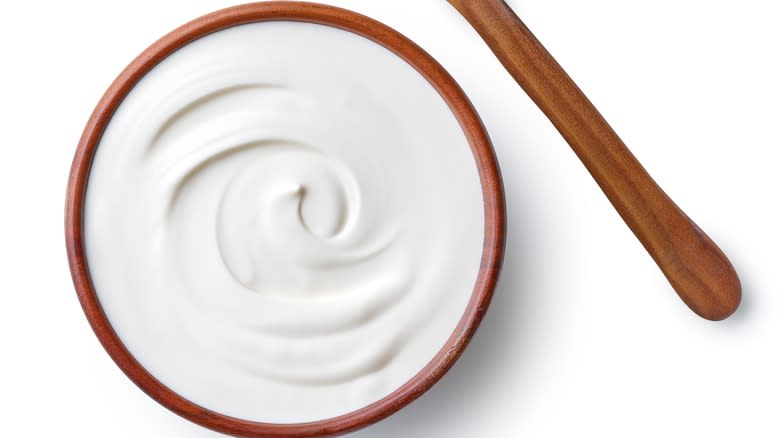
At first, sour cream biscuits might not sound all that different from buttermilk biscuits. In both cases, you're adding a creamy yet tangy dairy product to the dough, but the two have different amounts of fat. Buttermilk doesn't have much fat in it, and it's a great way to add flavor to dough without increasing the fat gram and calorie counts by much. Sour cream, however, contains a lot of fat and produces an extremely moist biscuit batter, the type you drop into a muffin tin instead of kneading and placing on a baking sheet.
It's really the fat content that separates sour cream biscuits from other biscuits. Fat produces tender cakes, breads, and biscuits by making gluten strands in the dough shorter. Longer gluten strands lead to tougher textures that you have to chew more. Shortening those strands makes the final product softer. Sour cream has so much fat in it that the baked biscuits are melt-in-your-mouth tender.
Rolled
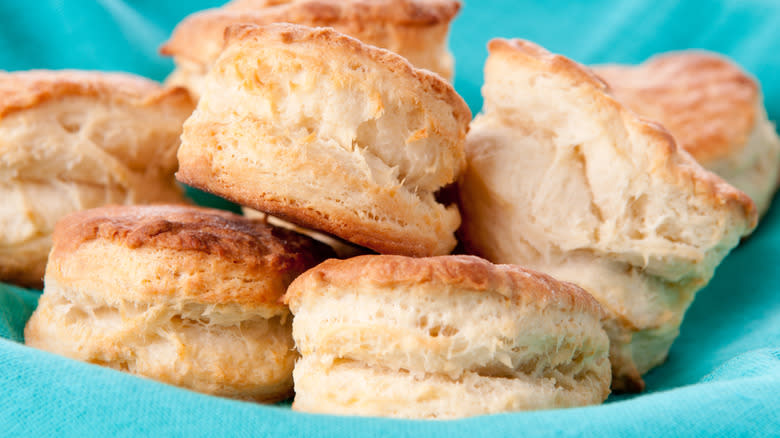
The distinguishing feature of rolled biscuits is in their name: The dough is rolled out and folded back on itself a few times to form layers. Biscuit shapes are cut out either with a special cutter or with a knife, if you want the biscuits to be square. When rolled and cut correctly, the dough rises and forms layers that you can peel off and eat one by one. As mentioned, buttermilk biscuits are typically rolled biscuits.
One issue that people often have when making rolled biscuits is that they end up with biscuits that don't rise much and that don't have those flaky layers that are so fun to pull apart. This happens if you use one of two specific cutting methods. If you use a glass or some other improvised cutter with a thick edge, you don't get that precise slicing action that you do with an actual biscuit cutter. The edge of the glass drags the edges of the dough down with it, and the dough doesn't separate as well during baking. You can still use a glass to cut the biscuits; just don't expect much of a rise.
The second method involves twisting the cutter to ensure it cuts all the way through the dough. That twisting motion actually seals the sides of the biscuit, preventing much of a rise. When you use a biscuit cutter, cut straight down, and don't twist.
Drop
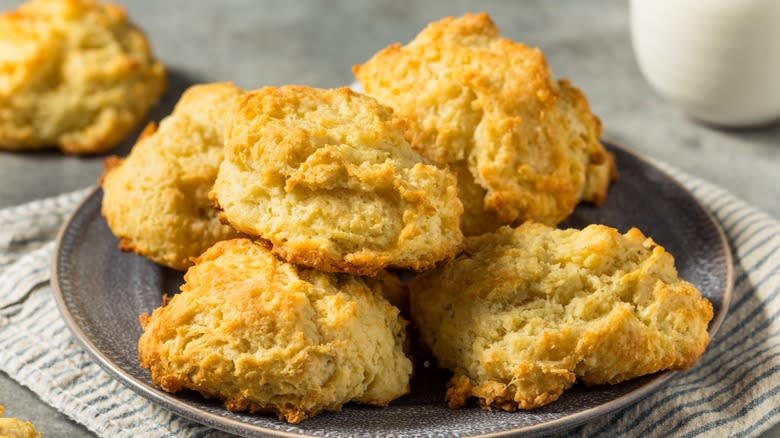
Drop biscuits are made by literally dropping dough onto a pan or whatever type of baking surface you're using. The dough isn't really shaped, and it's certainly not rolled out and cut; it's too moist for that and is more like a stiff batter than a kneadable dough. You just drop dollops of the dough/batter into a reasonably sized mound and bake away. These are also sometimes called emergency biscuits because of how quickly you can make them, especially if you use self-rising flour. All that rolling and cutting takes time that you might not have, but dropping is speedy. Drop biscuits aren't meant to be pretty, but they do turn out nice and soft.
We're including cathead biscuits with drop biscuits because cathead biscuits usually are drop biscuits, just really big. The name, in many a family's oral history, comes from some older relative saying the biscuits were as big as a cat's head. The biscuits are a common sight in restaurants around the Mississippi Delta. One thing to know about cathead biscuits is that a lot of people make them as rolled biscuits rather than drop biscuits, so they could be either type; whichever way you decide to make them, be sure to make them appropriately large.
Shortcake
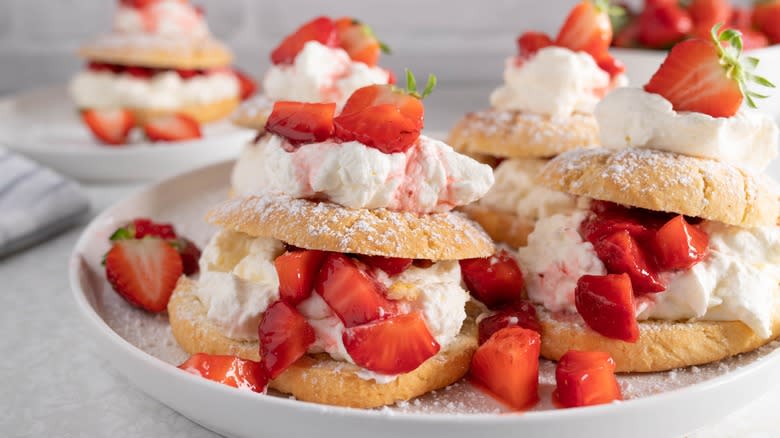
Shortcakes are those sweet biscuits you have with whipped cream and fruit. They're a delight and definitely a dessert biscuit; you really wouldn't see shortcake biscuits served with lunch meat, for example (but we're not going to stop you if you want to try it). They're usually served split in half horizontally, although they can be served whole. These tend to be very light in color, somewhat crumbly, and rich, with butter being a key ingredient.
These are not the same as the spongecake cups that grocery stores often carry, and you'll find comments online about how sometimes the biscuit version of shortcake can be too sweet. If you make them, keep the sugar level moderate; the sweetness of the fruit should be the star of the show, and you don't want the sweetness of the shortcake to overpower the toppings. Plus, too much sugar in the shortcakes will make them resemble cookies and change their texture.
Angel
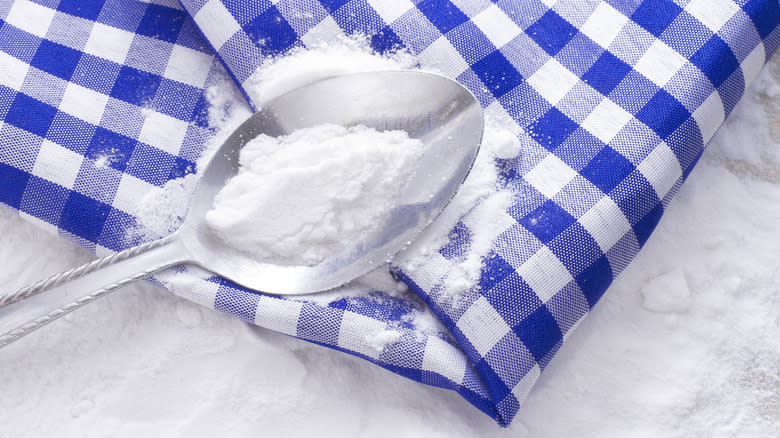
Angel biscuits are possibly the softest of the bunch due to a one-two punch with yeast and baking powder. Either one of these ingredients on its own will make the rest of the biscuit dough rise (although yeast isn't typically used with biscuits), but using both makes the dough rise very high. Some recipes even use baking soda in addition to the other two leavening agents. The resulting biscuit is super soft, airy, and a joy to bite into.
Surprisingly, angel biscuits are still fairly sturdy and keep their shape well while baking. The yeast does make them a little more like a bread roll, and you can try to use them for small breakfast sandwiches. However, their texture is so light that they remain firmly in the biscuit category. Angel biscuits were created around 1950 by a Southern flour brand, although it's not known for sure just which brand thought them up.
Soda
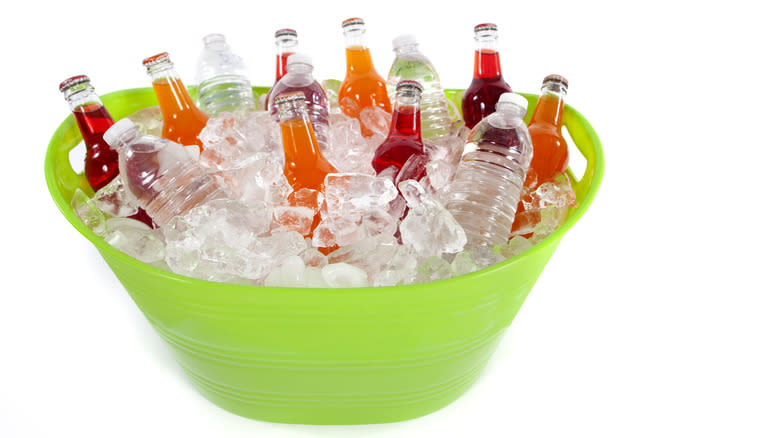
Soda biscuits can be a bit confusing because you'll see the name refer to two different types of biscuits. One, made with baking soda, is more like a buttermilk or rolled biscuit that uses the baking soda as a leavening agent. When baking soda and baking powder were commercially available for use in food, they created a small revolution that allowed cooks to make lighter biscuits that didn't need yeast to rise.
The other type of soda biscuit is a biscuit made literally with soda, as in the carbonated stuff you drink. This isn't as strange as it sounds, and if you've ever made a cola cake or a similar recipe, you know that carbonated soda or pop is terrific at making food lighter -- think about when you add seltzer to batter that will coat fried food. Also, soda adds flavor and sugar, and it's an inexpensive ingredient. Using soda in baked goods began around the Great Depression and World War II when cooks had to find cheap substitutes for sugar.
Southern-style
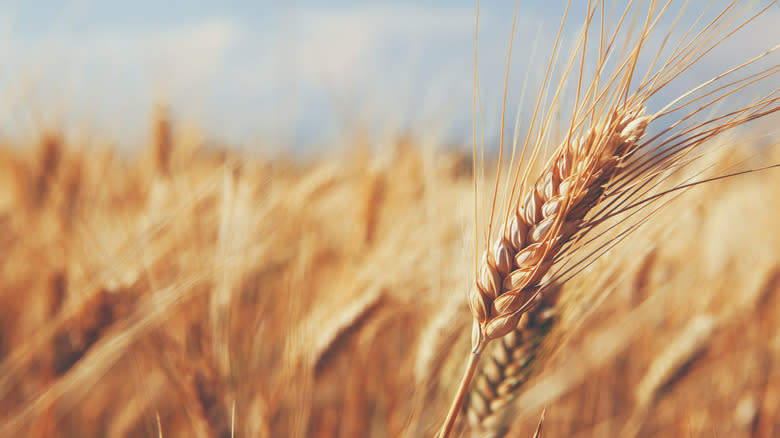
Southern-style biscuits can be buttermilk biscuits, non-buttermilk rolled biscuits, drop biscuits, you name it -- as long as the recipe uses soft winter wheat flour. The type of flour cultivated around the Southeastern U.S. is milled from a soft red winter wheat, while much of the flour produced in the rest of the country is milled from hard wheat; the difference shows up in the formation of gluten and the amount of protein. Soft wheat has lower protein levels (around 9% rather than 11.5%) and forms less gluten than hard wheat. These lower gluten levels produce a lighter, fluffier biscuit, and the lower protein levels help the biscuit rise a lot. Unfortunately, this fact isn't well-known outside of the South, and it's common to find people frustrated with how heavy their biscuits turn out. It's not that they're bad bakers; it's that they just don't know that they need a specific type of flour.
If you don't have access to soft wheat flour (White Lily is the brand you hear about most when Southern-style biscuits are the topic of discussion), you can still make biscuits with other flours. You just won't get that very tall, fluffy texture that so many in the South are able to get when they bake biscuits. If you can get some soft wheat flour, try experimenting and comparing biscuits made with soft and hard wheat flours.
Skillet
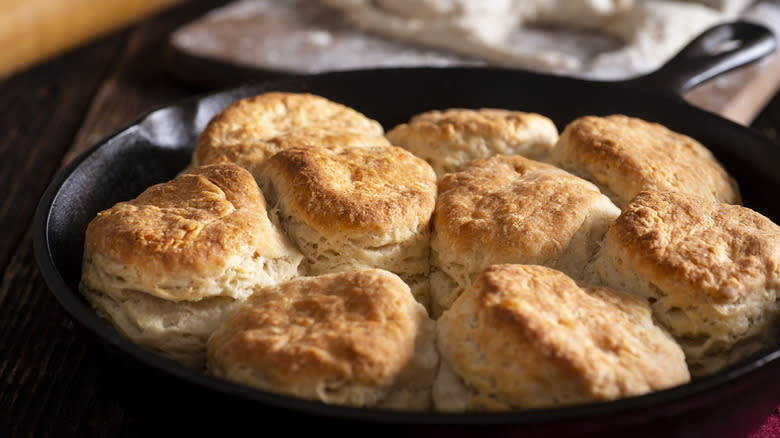
Skillet biscuits get their name from how they're cooked: in a skillet, squeezed together with several other biscuits. The skillet is usually cast iron, but just about any oven-safe skillet should do. Some recipes call for the biscuits to be baked in an oven (which is one reason a cast-iron skillet is usually the pan of choice), while others have the pan on the stove.
In either case, the skillet gives the biscuits a nice crust on the bottom that isn't too hard, and the crowded environment may help the biscuits rise. Because the dough can't expand outward, it expands upward, so you get these tall, fluffy biscuits. And, because the biscuits are all pressed up against each other, the sides of the biscuits don't develop much of a crust. Obviously, this method may not be the best for batter-based biscuits like sour cream and drop biscuits; they'd all meld into one big biscuit. If you want individual pieces that you don't have to slice like a pie, use a recipe with a more stable dough, such as buttermilk biscuits.
Read the original article on Mashed

